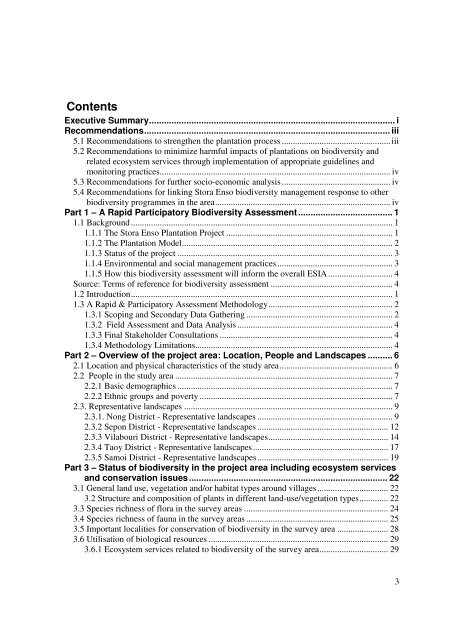Part 1 – A Rapid Participatory Biodiversity Assessment - IUCN
Part 1 – A Rapid Participatory Biodiversity Assessment - IUCN
Part 1 – A Rapid Participatory Biodiversity Assessment - IUCN
You also want an ePaper? Increase the reach of your titles
YUMPU automatically turns print PDFs into web optimized ePapers that Google loves.
Contents<br />
Executive Summary................................................................................................... i<br />
Recommendations................................................................................................... iii<br />
5.1 Recommendations to strengthen the plantation process .................................................iii<br />
5.2 Recommendations to minimize harmful impacts of plantations on biodiversity and<br />
related ecosystem services through implementation of appropriate guidelines and<br />
monitoring practices........................................................................................................ iv<br />
5.3 Recommendations for further socio-economic analysis................................................. iv<br />
5.4 Recommendations for linking Stora Enso biodiversity management response to other<br />
biodiversity programmes in the area............................................................................... iv<br />
<strong>Part</strong> 1 <strong>–</strong> A <strong>Rapid</strong> <strong>Part</strong>icipatory <strong>Biodiversity</strong> <strong>Assessment</strong>...................................... 1<br />
1.1 Background ...................................................................................................................... 1<br />
1.1.1 The Stora Enso Plantation Project ........................................................................... 1<br />
1.1.2 The Plantation Model............................................................................................... 2<br />
1.1.3 Status of the project ................................................................................................. 3<br />
1.1.4 Environmental and social management practices .................................................... 3<br />
1.1.5 How this biodiversity assessment will inform the overall ESIA ............................. 4<br />
Source: Terms of reference for biodiversity assessment ....................................................... 4<br />
1.2 Introduction...................................................................................................................... 1<br />
1.3 A <strong>Rapid</strong> & <strong>Part</strong>icipatory <strong>Assessment</strong> Methodology........................................................ 2<br />
1.3.1 Scoping and Secondary Data Gathering .................................................................. 2<br />
1.3.2 Field <strong>Assessment</strong> and Data Analysis ...................................................................... 4<br />
1.3.3 Final Stakeholder Consultations .............................................................................. 4<br />
1.3.4 Methodology Limitations......................................................................................... 4<br />
<strong>Part</strong> 2 <strong>–</strong> Overview of the project area: Location, People and Landscapes .......... 6<br />
2.1 Location and physical characteristics of the study area................................................... 6<br />
2.2 People in the study area .................................................................................................. 7<br />
2.2.1 Basic demographics ................................................................................................. 7<br />
2.2.2 Ethnic groups and poverty ....................................................................................... 7<br />
2.3. Representative landscapes .............................................................................................. 9<br />
2.3.1. Nong District - Representative landscapes ............................................................. 9<br />
2.3.2 Sepon District - Representative landscapes ........................................................... 12<br />
2.3.3 Vilabouri District - Representative landscapes...................................................... 14<br />
2.3.4 Taoy District - Representative landscapes............................................................. 17<br />
2.3.5 Samoi District - Representative landscapes........................................................... 19<br />
<strong>Part</strong> 3 <strong>–</strong> Status of biodiversity in the project area including ecosystem services<br />
and conservation issues................................................................................ 22<br />
3.1 General land use, vegetation and/or habitat types around villages................................ 22<br />
3.2 Structure and composition of plants in different land-use/vegetation types............. 22<br />
3.3 Species richness of flora in the survey areas ................................................................. 24<br />
3.4 Species richness of fauna in the survey areas ................................................................ 25<br />
3.5 Important localities for conservation of biodiversity in the survey area ....................... 28<br />
3.6 Utilisation of biological resources ................................................................................. 29<br />
3.6.1 Ecosystem services related to biodiversity of the survey area............................... 29<br />
3

















